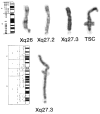Chromosome lesions which could be interpreted as "fragile sites" on the distal end of Xq
- PMID: 2248293
- PMCID: PMC5453803
- DOI: 10.1002/ajmg.1320370217
Chromosome lesions which could be interpreted as "fragile sites" on the distal end of Xq
Abstract
Chromosome lesions which could be interpreted as "fragile sites" on the distal end of the long arm of the X chromosome were identified during a cytogenetic study of 160 mentally retarded adult males with no apparent cause of their mental retardation and one normal adult female with a family history of fra (X) syndrome. Peripheral blood samples were cultured in either M199 or RPMI 1640 medium with FUdR or BrdU. Metaphases were examined for chromosome lesions or fragile sites on the distal end of Xq and 3 distinct sites were observed: Xq26, Xq27.2, and Xq27.3. Other chromosome lesions at Xq28 were observed and interpreted as nonspecific telomeric structural changes. Chromosome lesions were observed in cells from 14 of the 161 individuals. These included: 5 patients with an Xq26 site, 2 with the recently reported Xq27.2 site, 4 with the Xq27.3 site (characteristic of the fra (X) syndrome), 2 with nonspecific telomeric structural changes, and one individual with 2 lesions (a nonspecific telomeric structural change and an Xq26 site). Additional research is necessary to determine the frequency and clinical significance, if any, of lesions occurring in this region of the X chromosome and to distinguish among heritable fragile sites, constitutive fragile sites, and nonspecific telomeric structural changes.
Figures

References
-
- Bühler EM, Hadziselimovic F, Pira U. A variant of the fra(X) syndrome. Hum Genet. 1982;61:273–275. - PubMed
-
- Chudley AE, Hagerman RJ. Fragile X Syndrome. J Pediatr. 1987;110:821–831. - PubMed
-
- Glover TW, Berger C, Coyle J, Echo B. DNA polymerase a inhibition by aphidicolin induces gaps and breaks at common fragile sites in human chromosomes. Hum Genet. 1984;67:136–142. - PubMed
-
- Hagerman RJ, McBogg PM. The Fragile X Syndrome, Diagnosis Biochemistry, Intervention. Dillon, Colorado: Spectra Publishing Co., Inc; 1983.
-
- Jenkins EC, Brown WT, Brooks J, Duncan CJ, Sanz MM, Silverman WP, Kusum PL, Masia A, Katz E, Lubin RA, Nolin SL. Low frequencies of apparently fragile X chromosomes in normal control cultures: A possible explanation. Exp Cell Biol. 1986;54:40–48. - PubMed
Publication types
MeSH terms
Grants and funding
LinkOut - more resources
Full Text Sources
Medical
